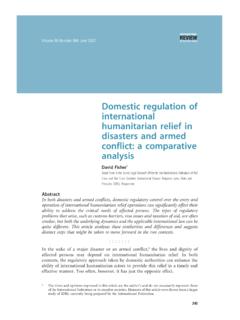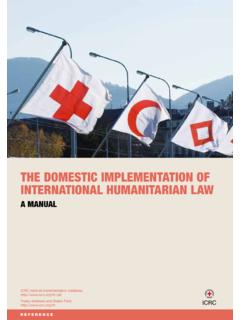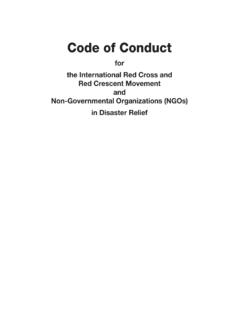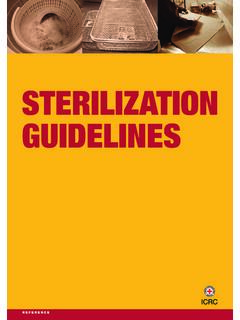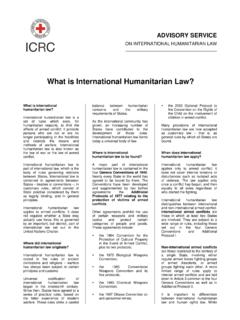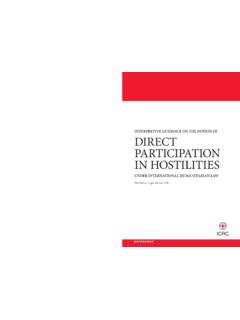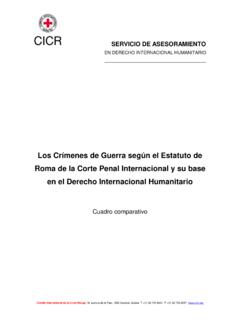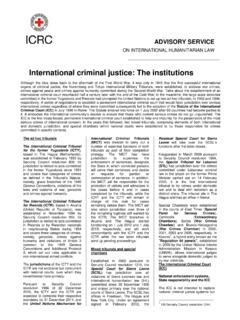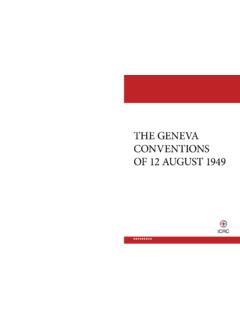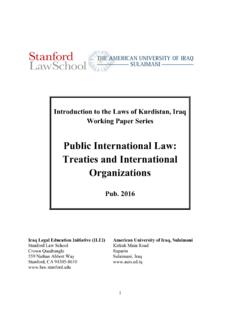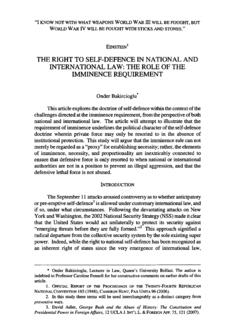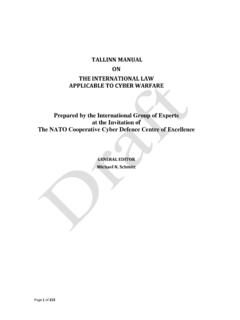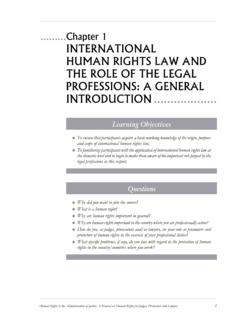Transcription of Typology of armed conflicts in international humanitarian ...
1 Typology of armedconflicts ininternationalhumanitarian law: legal concepts andactual situationsSylvain Vite *Sylvain Vite is legal advisor in the legal Division of the international Committee ofthe Red international humanitarian law has as its aim the limitation of the effects ofarmed conflict, it does not include a full definition of those situations which fall withinits material field of application. While it is true that the relevant conventions refer tovarious types of armed conflict and therefore afford a glimpse of the legal outlines ofthis multifaceted concept , these instruments do not propose criteria that are preciseenough to determine the content of those categories unequivocally. A certain amount ofclarity is nonetheless needed.
2 In fact, depending on how the situations are legallydefined, the rules that apply vary from one case to the next. By proposing a Typology ofarmed conflicts from the perspective of international humanitarian law, this articleseeks to show how the different categories of armed conflict anticipated by that legalregime can be interpreted in the light of recent developments in international legalpractice. It also reviews some actual situations whose categorization under existinglegal concepts has been 91 Number 873 March 2009*The views expressed in this article reflect the author s opinions and not necessarily those of the author would like to express his sincere gratitude to his colleagues in the ICRC s legal Divisionwho contributed to the ideas developed in this article, especially to Laurent Colassis, Tristan Ferraro,Jean-Marie Henckaerts and Kathleen international humanitarian law has as its aim the limitation of the effectsof armed conflict, it does not include a full definition of those situations that fallwithin its material field of application.
3 While it is true that the relevant conventionsrefer to various types of armed conflict and therefore afford a glimpse of the legaloutlines of this multifaceted concept , these instruments do not propose criteriathat are precise enough to determine the content of those categories certain amount of clarity is nonetheless needed. In fact, depending on how thesituations are legally defined, the rules that apply vary from one case to the legal regimes that need to be taken into account are thus not always the sameand depend on whether the situations constitute, for example, an international or anon- international armed conflict. Similarly, some forms of violence, referred to as internal tensions or internal disturbances , do not reach the threshold ofapplicability of international humanitarian law and therefore fall within the scopeof other normative article proposes a Typology of armed conflicts from the perspective ofinternational humanitarian law.
4 It sets out, first, to show how the different cat-egories of armed conflict anticipated by that law can be interpreted in the light ofrecent developments in international legal practice. In that respect, it is appropriateto refer to the conceptualization efforts relating firstly to the law of internationalarmed conflict and secondly to the law of non- international armed conflict. Thisarticle then goes on to examine various controversial cases of application. Thereality of armed conflict is actually more complex than the model described ininternational humanitarian law to the extent that today some observers questionthe adequacy of the legal law of international armed conflictThe history of the law of international armed conflict shows that the field of ap-plication of this legal regime has been progressively extended as treaty law devel-oped.
5 Whereas a narrow formalistic concept of war was predominant initially, thereform of the system with the revision of the Geneva Conventions in 1949 gaveprecedence to a broader approach, based on the more objective concept of armedconflict. Moreover, that extension was subsequently taken up with the adoption ofAdditional Protocol I in 1977. That instrument added another type of conflict tothe field of the law of international armed conflict, that of wars of national liber-ation. This legal regime also comprises a specific body of rules whose field of ap-plication is determined on the basis of an autonomous concept , that of and international armed conflictBy virtue of common Article 2(1), the 1949 Geneva Conventions apply to all casesof declared war or of any other armed conflict which may arise between two or70S.
6 Vite Typology of armed conflicts in international humanitarian law: legal concepts and actualsituationsmore of the High Contracting Parties, even if the state of war is not recognized byone of them .1 The situations referred to here are conflicts between States. The High Contracting Parties mentioned in this text are sovereign entities. Dependingon the case in question, these situations may take the form of a direct conflictbetween States or of intervention in a previously existing internal conflict. In thelatter hypothesis, the conflict is internationalized . That is the case if a foreignPower sends troops into a territory to support a movement opposing the localgovernment.
7 Intervention may also take place by proxy when that Power merelysupports and guides the uprising from a that case, it is then vital todetermine the level of control that makes it possible to classify the armed conflict asinternational. Not every form of influence necessarily leads to the conflict becom-ing internationalized. On that point, the international Criminal Tribunal for theformer Yugoslavia (ICTY) pointed out that control by a State over subordinatearmed forces or militias or paramilitary units may be of an overall character (andmust comprise more than the mere provision of financial assistance or militaryequipment or training). This requirement, however, does not go so far as to includethe issuing of specific orders by the State, or its direction of each individual oper-ation.
8 3 The criterion of overall control is achieved when the foreign State has arole in organising, co-ordinating or planning the military actionsof the militarygroup, in addition to financing, training and equipping or providing operationalsupport to that group (emphasis added).4 Involvement must therefore go beyondmere logistical support, but that involvement does not imply that everything doneby the group concerned is directed by the State taking part from a situations referred to in Article 2(1) common to the 1949 GenevaConventions are viewed from the twin viewpoints of formalism and same field of application was also retained for other instruments of international humanitarian law,in particular Additional Protocol I (see Art.)
9 1(3)).2 international Criminal Tribunal for the former Yugoslavia (ICTY), , Case No. IT-94-1-A, Judgment (Appeals Chamber), 15 July 1999, para 84: It is indisputable that an armed conflict isinternational if it takes place between two or more States. In addition, in case of an internal armedconflict breaking out on the territory of a State, it may become international (or, depending upon thecircumstances, be international in character alongside an internal armed conflict) if (i) another Stateintervenes in that conflict through its troops, or alternatively if (ii) some of the participants in theinternal armed conflict act on behalf of that other State. 3 Ibid., para 137. On this point, see also international Court of Justice (ICJ),Application of the Conventionon the Prevention and Punishment of the Crime of Genocide (Bosnia and andMontenegro), Judgment,ICJ Reports 2007, 26 February 2007, para 404.
10 Without adopting a definitiveposition on the matter, the Court accepted that the criterion of overall control may be applicable andsuitable as a means of determining whether or not an armed conflict is international . For a discussion ofthis issue, see A. Cassese, TheNicaraguaandTadicTests Revisited in Light of the ICJ Judgment onGenocide in Bosnia ,European Journal of international Law, Vol. 18, No. 4, 2007, pp. 649 , , Judgment (Appeals Chamber), above note 2, para 137; see also paras 120 and131. See also ICTY, , Case No. IT-98-34-T, Judgment (Trial Chamber), 31 March2003, para 198. For an analysis of this case law, see Stewart, Towards a Single Definition of ArmedConflict in international humanitarian Law: a Critique of Internationalized armed Conflict , international Review of the Red Cross, Vol.
